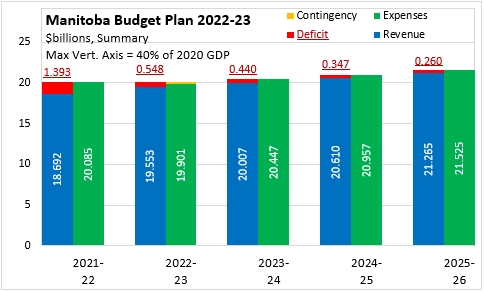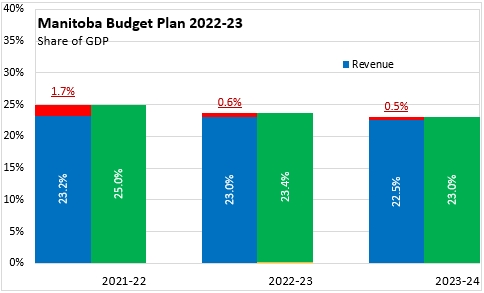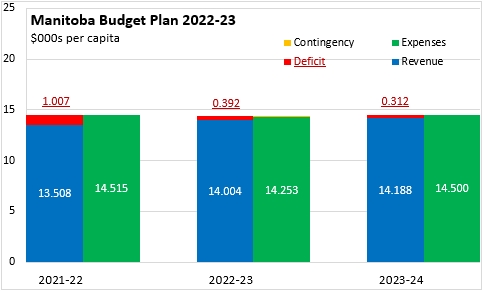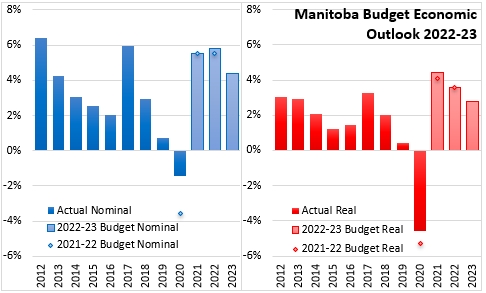The Economics and Statistics Division maintains archives of previous publications for accountability purposes, but makes no updates to keep these documents current with the latest data revisions from Statistics Canada. As a result, information in older documents may not be accurate. Please exercise caution when referring to older documents. For the latest information and historical data, please contact the individual listed to the right.
<--- Return to Archive
For additional information relating to this article, please contact:
April 13, 2022MANITOBA BUDGET 2022-23 Manitoba tabled its 2022-23 Budget on April 12, 2022. The deficit for 2022-23 is estimated at $548 million, down from the $1.393 billion forecast for 2021-22. The deficit is expected to decline steadily each year through 2025-26. Revenue growth for 2022-23 is projected at 4.6% while expenditures are projected to contract by 0.9%. Between 2022-23 and 2025-26, Manitoba provincial revenues are projected to grow at an annual average pace of 2.8% while expenditures grow by 2.6% per year.

As in many provinces, Manitoba's provincial revenues in 2021-22 were notably higher than estimates ($854 million). Expenditures were $650 million higher than the 2021-22 estimates. For 2022-23 and beyond, both revenues and expenditures are projected to be notably higher than anticipated in the 2021-22 fiscal plan.

Manitoba's revised fiscal plan for 2022-23 anticipates slightly larger deficits than the plan announced in the 2021-22 Budget. The deficit is projected to continue through 2025-26, but the Budget Speech notes that the deficit is expected to be eliminated over the next 7 years.

The Manitoba Budget deficit for 2022-23 amounts to 0.6% of GDP, down from 1.7% forecast for 2021-22. The footprint of Manitoba's government relative to its GDP estimated at 25.0% of GDP in 2021-22. Over the next two years, this is projected to shrink to 23.0% of GDP (longer projections of nominal GDP are not published).
Manitoba's net debt is estimated to be 36.4% of GDP as of the end of 2021-22. Manitoba's net debt to GDP figure is projected to fall to 35.9% by the end of 2022-23 and to 34.8% of GDP by the end of 2025-26.

On a per capita basis, the Manitoba Budget for 2022-23 amounts to $14,253 in expenditures against $14,004 per capita in revenues and $392 per capita in deficit.

Manitoba's economic contraction in 2020 was milder than estimated in the 2021-22 Budget. However, the outlook for economic rebound estimated in 2021 and 2022 is similar to the projections from the previous fiscal plan. Real GDP is projected to grow by 3.6% in 2022 after rebounding by 4.4% in 2021. Nominal GDP growth is projected to be 5.8% in 2022, accelerating from 5.5% estimated for 2021. In 2023, Manitoba's real GDP growth is projected to slow to 2.8% while nominal GDP growth slows to 4.4%. Manitoba's economic outlook is predicated on continued strength in consumer spending as labour markets recover and population grows, while exports rebound. However, this is tempered by cautions around risks from the pandemic, supply chain problems, labour shortages, climate change, geopolitical instability from Russia's invasion of Ukraine and inflation.

Key Measures and Initiatives
The Manitoba Budget for 2022-23 prioritizes: health care, affordability, economic growth, communities and the environment. Key initiatives include:
Heath care
- $110 million to address diagnostic and surgical backlogs
- $17 million for the first year of a 5-year plan for mental health and wellness
- $20 million for implementation of the Seniors Strategy
- $32 million for full implementation of all recommendations of the Stevenson Review (on home care)
- $11 million to increase nursing enrolment
- $630 million dedicated to contingencies and COVID-19 response and recovery
Affordability
- Increasing the Education Property Tax Rebate to 50 per cent by 2023
- Introducing a new Residential Renters Tax Credit
- Expanding eligibility for the Child Care Subsidy Program
- Increasing shelter benefits for low income Manitobans: $17.9 million rent assist indexation
- $12 million in new income support programs for people with severe and prolonged disabilities
- Reducing vehicle registration fees
Econonmic growth
- Launching a new Venture Capital Fund with an initial investment of $50 million
- Making the Small Business Venture Capital Tax Credit permanent and expanding it to
support venture capital funds
- $5 million in immigration programming
- More than $2 million supporting new property development in Manitoba
- More than $18 million for improving the wages of front-line workers in the Community Living Disability, Children’s Disability and Family Violence Prevention
Communities
- Creating 716 spaces in new child-care centres and supporting 50 new home-based spaces this year
- Building 22 new schools by 2027
- Supporting arts, culture and sports organizations with $100 million over three years
- Additional $10.3 million for enhancing the Building Sustainable Communities Program,
- $5 million for advancing progress on reconciliation activities
Environment
- $6 million for 12 initiatives for advancing the Made-in-Manitoba Climate and Green Plan and expanding the Conservation and Climate Fund
- $50 million over two years for accelerating the remediation and rehabilitation of orphaned and abandoned mine sites
- $10 million for forestry programs
- $14 million for provincial parks
- $100 million for the Lake Manitoba and Lake St. Martin Outlet Channels Projects
Manitoba Budget 2022-23
<--- Return to Archive